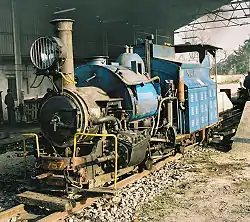Oil burner (engine)
An oil burner engine is a steam engine that uses oil as its fuel. The term is usually applied to a locomotive or ship engine that burns oil to heat water, to produce the steam which drives the pistons, or turbines, from which the power is derived.

This is mechanically very different from diesel engines, which use internal combustion, although they are sometimes colloquially referred to as oil burners.[1]
An early pioneer of this form of engine was James Holden,[2][3] of Britain's Great Eastern Railway. In James Holden's system, steam was raised by burning coal before the oil fuel was turned on.[4]
Conversion
Some oil-burning engines were originally designed to be coal powered but were converted. When a coal-burning steam locomotive is converted to burn oil, various modifications are usual:
- the grate is covered with broken firebrick to act as a reservoir of heat. If the oil flame is blown out (e.g. by a downdraft when entering a tunnel) the hot firebrick will re-ignite it
- the lower part of the inner firebox is lined with firebrick
- shorter superheater elements are fitted
The latter two changes are needed because oil firing produces higher temperatures than coal firing, and can cause rapid erosion of metal. For a similar reason, the smokebox is sometimes painted with silver-coloured heat-resisting paint.
Oil-fired steam locomotives
Great Britain
James Holden's use of oil firing on the Great Eastern Railway is mentioned above and it was used sporadically on Britain's railways, usually because of coal shortages.[5] A Parliamentary question was asked about it in 1919.[6]
New Zealand
- NZR JA class (North British-built locomotives only)
- NZR JB class
- NZR K class (1932) - converted from coal 1947-53
- NZR KA class - converted from coal 1947-53
North America
- Sierra Railway 3 - Part of Railtown 1897 State Historic Park
- Sierra Railway 28 - Part of Railtown 1897 State Historic Park
- Alaska Railroad 557 - Engine 557 Restoration Company
- Fillmore and Western 14 - Fillmore and Western Railroad
- Weyerhauser Timber Co. 110 - Black Hills Central Railroad
- Saginaw Timber Co. (Polson Logging Co.) 2 - Mid-Continent Railway Museum
- McCloud Railway 25 - Oregon Coast Scenic Railroad (Garibaldi, OR)
- Cowlitz, Chehalis and Cascade 15 - Chehalis-Centralia Railroad
- California Western 45 - California Western Railroad (Fort Bragg, CA)
- Great Smoky Mountains 1702 - Great Smoky Mountains Railroad (Bryson City, NC)
- Grand Canyon Railway 29 - Grand Canyon Railway (Williams, AZ)
- Grand Canyon Railway 4960 - Grand Canyon Railway (Williams, AZ)
- Union Pacific 844 - UP Heritage Fleet (Cheyenne, WY)
- Union Pacific 3985 - UP Heritage Fleet (Cheyenne, WY)
- Union Pacific 4014 - UP Heritage Fleet (Cheyenne, WY)
- Union Pacific 737
- Mount Washington Cog Railway [7]
- White Pass & Yukon Route 69 - White Pass and Yukon Route (Skagway, AK)
- White Pass & Yukon Route 73 - White Pass and Yukon Route (Skagway, AK)
- Rio Grande K-28 class 473 - Durango and Silverton Narrow Gauge Railroad (Durango and Silverton, CO)
- Rio Grande K-36 class 480 - Durango and Silverton Narrow Gauge Railroad (Durango and Silverton, CO)
- Rio Grande K-36 class 489 - Cumbres and Toltec Scenic Railroad (Chama, NM and Antonito, CO)
- Rio Grande K-37 class 493 - Durango and Silverton Narrow Gauge Railroad (Durango and Silverton, CO)
- Oregon Railroad & Navigation 197 - Oregon Rail Heritage Center (Portland, OR)
- Spokane, Portland & Seattle 700 - Oregon Rail Heritage Center (Portland, OR)
- Southern Pacific 4449 - Oregon Rail Heritage Center (Portland, OR)
- Southern Pacific 4460 - Museum of Transportation (Kirkwood, MO)
- Southern Pacific 4294 - California State Railroad Museum (Sacramento, CA)
- Southern Pacific 2472 - Golden Gate Railroad Museum
- Southern Pacific 2467 - Pacific Locomotive Association, Inc.
- Southern Pacific 2479 - California Trolley and Railroad Corporation
- Southern Pacific 18 - Eastern California Museum (Independence, CA)
- Santa Fe 3759 - Locomotive Park (Kingman, AR)
- Santa Fe 3415 - Abilene and Smoky Valley Railroad (Abilene, KS)
- Santa Fe 3751 - San Bernardino Railroad Historical Society (San Bernardino, CA)
- Santa Fe 2926 - New Mexico Steam Locomotive and Railroad Historical Society (Albuquerque, NM)
- Santa Fe 5000
- Santa Fe class 3450 - RailGiants Train Museum (Pomona, CA)
- St. Louis Southwestern 819 - Arkansas Railroad Museum (Pine Bluff, AR)
- SLSF 1522 - Museum of Transportation (Kirkwood, MO)
- Texas and Pacific 610 - Texas State Railroad (Palestine, TX)
- Great Northern 2507
- Great Northern 2523
- Disneyland Railroad Nos. 1, 2, 3, 4 and 5 - Disneyland (Anaheim, CA)
- Walt Disney World Railroad Nos. 1, 2, 3 and 4 - Walt Disney World (Orlando, FL)
- Frisco Silver Dollar Line Nos. 43, 13, 76, 504 and 14 - Silver Dollar City (Branson, MO)
- Southern Railway 385
- Southern Railway 401 - Monticello Railway Museum (Monticello, IL)
General
- Most cab forward locomotives
- Some Fairlie locomotives
- Advanced steam technology locomotives
Oil-fired steamships
.jpg.webp)
- USS Drayton (DD-23)
- USS Terry (DD-25)
- USS Perkins (DD-26)
- USS Sterett (DD-27)
- USS McCall (DD-28)
- USS Warrington (DD-30)
- USS Burrows (DD-29)
- USS Monaghan (DD-32)
- USS Trippe (DD-33)
- USS Walke (DD-34)
- USS Ammen (DD-35)
- USS Jarvis (DD-38)
- USS Henley (DD-39)
- USS Jouett (DD-41)
- USS Jenkins (DD-42)
- USS George Washington (1908)
References
- Spinelli, Mike (2006-05-25). "Diesel on the Range: Land Rover Flagship to Come in Oil-Burner". Jalopnik. Retrieved 2017-09-08.
- Cletus H. Jones (1985). Marine Fuels. ASTM International. ISBN 0-8031-0425-1.
- Alan J. Goldfinch (2004). How Steam Locomotives Really Work. Oxford University Press. ISBN 0-19-860782-2.
- http://www.lner.info/co/GER/locomotives.shtml
- Sabourin, A. (July 1913). "Notes sur l'industrie des transports". La technique moderne. 5: 36–37.
- "OIL FUEL LOCOMOTIVES. (Hansard, 18 December 1919)". api.parliament.uk. Retrieved 2019-04-25.
- http://www.martynbane.co.uk/modernsteam/nday/mw/ndaymw-biodiesel.html